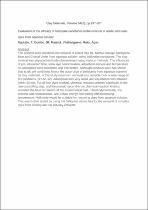 ResearchSpace
ResearchSpace
Evaluation of the efficacy of halloysite nanotubes in the removal of acidic and basic dyes from aqueous solution
JavaScript is disabled for your browser. Some features of this site may not work without it.
- ResearchSpace
- →
- Research Publications/Outputs
- →
- Journal Articles
- →
- View Item
| dc.contributor.author |
Ngulube, T

|
|
| dc.contributor.author |
Gumbo, JR

|
|
| dc.contributor.author |
Masindi, Vhahangwele

|
|
| dc.contributor.author |
Maity, Arjun

|
|
| dc.date.accessioned | 2019-09-25T06:44:54Z | |
| dc.date.available | 2019-09-25T06:44:54Z | |
| dc.date.issued | 2019-06 | |
| dc.identifier.citation | Ngulube, T., Gumbo, J.R., Masindi, V. and Maity, A. 2019. Evaluation of the efficacy of halloysite nanotubes in the removal of acidic and basic dyes from aqueous solution. Clay Materials, v 54(2), pp 197-207. | en_US |
| dc.identifier.issn | 0009-8558 | |
| dc.identifier.issn | 1471-8030 | |
| dc.identifier.uri | https://www.cambridge.org/core/journals/clay-minerals/article/evaluation-of-the-efficacy-of-halloysite-nanotubes-in-the-removal-of-acidic-and-basic-dyes-from-aqueous-solution/DD24C4A74D8101950E0B3A883DEA7FD4 | |
| dc.identifier.uri | DOI: https://doi.org/10.1180/clm.2019.27 | |
| dc.identifier.uri | http://hdl.handle.net/10204/11122 | |
| dc.description | Copyright: 2019 Cambridge University Press. Due to copyright restrictions, the attached PDF file only contains the abstract of the full text item. For access to the full text item, kindly consult the publisher's website. | en_US |
| dc.description.abstract | The present work describes the removal of Direct Red 81, Methyl Orange, Methylene Blue and Crystal Violet from aqueous solution using halloysite nanotubes. The clay mineral was physicochemically characterized using various methods. The influences of pH, interaction time, initial dye concentration, adsorbent amount and temperature on adsorption were monitored and interpreted. Although previous work has shown that acidic pH conditions favour the adsorption of pollutants from aqueous systems by clay materials, in this study maximum removal was possible over a wide range of pH conditions (pH =2–12). Adsorption was very rapid, and equilibrium was attained within 30 min. For all four dyes studied, chemical reaction seemed significant in the rate-controlling step, and the pseudo-second-order chemical reaction kinetics provided the best correlation of the experimental data. Thermodynamically, the process was spontaneous, with Gibbs energy decreasing with increasing temperature. Halloysite would be suitable for removing dyes from aqueous solution. This was further tested by using the halloysite nanotubes for the removal of complex dyes from printing and ink industry effluents. | en_US |
| dc.language.iso | en | en_US |
| dc.publisher | Cambridge University Press | en_US |
| dc.relation.ispartofseries | Worklist;22610 | |
| dc.subject | Acidic and basic dyes | en_US |
| dc.subject | Adsorption | en_US |
| dc.subject | Halloysite nanotubes | en_US |
| dc.subject | Isotherms | en_US |
| dc.subject | Kinetics | en_US |
| dc.subject | Thermodynamics | en_US |
| dc.title | Evaluation of the efficacy of halloysite nanotubes in the removal of acidic and basic dyes from aqueous solution | en_US |
| dc.type | Article | en_US |
| dc.identifier.apacitation | Ngulube, T., Gumbo, J., Masindi, V., & Maity, A. (2019). Evaluation of the efficacy of halloysite nanotubes in the removal of acidic and basic dyes from aqueous solution. http://hdl.handle.net/10204/11122 | en_ZA |
| dc.identifier.chicagocitation | Ngulube, T, JR Gumbo, Vhahangwele Masindi, and Arjun Maity "Evaluation of the efficacy of halloysite nanotubes in the removal of acidic and basic dyes from aqueous solution." (2019) http://hdl.handle.net/10204/11122 | en_ZA |
| dc.identifier.vancouvercitation | Ngulube T, Gumbo J, Masindi V, Maity A. Evaluation of the efficacy of halloysite nanotubes in the removal of acidic and basic dyes from aqueous solution. 2019; http://hdl.handle.net/10204/11122. | en_ZA |
| dc.identifier.ris | TY - Article AU - Ngulube, T AU - Gumbo, JR AU - Masindi, Vhahangwele AU - Maity, Arjun AB - The present work describes the removal of Direct Red 81, Methyl Orange, Methylene Blue and Crystal Violet from aqueous solution using halloysite nanotubes. The clay mineral was physicochemically characterized using various methods. The influences of pH, interaction time, initial dye concentration, adsorbent amount and temperature on adsorption were monitored and interpreted. Although previous work has shown that acidic pH conditions favour the adsorption of pollutants from aqueous systems by clay materials, in this study maximum removal was possible over a wide range of pH conditions (pH =2–12). Adsorption was very rapid, and equilibrium was attained within 30 min. For all four dyes studied, chemical reaction seemed significant in the rate-controlling step, and the pseudo-second-order chemical reaction kinetics provided the best correlation of the experimental data. Thermodynamically, the process was spontaneous, with Gibbs energy decreasing with increasing temperature. Halloysite would be suitable for removing dyes from aqueous solution. This was further tested by using the halloysite nanotubes for the removal of complex dyes from printing and ink industry effluents. DA - 2019-06 DB - ResearchSpace DP - CSIR KW - Acidic and basic dyes KW - Adsorption KW - Halloysite nanotubes KW - Isotherms KW - Kinetics KW - Thermodynamics LK - https://researchspace.csir.co.za PY - 2019 SM - 0009-8558 SM - 1471-8030 T1 - Evaluation of the efficacy of halloysite nanotubes in the removal of acidic and basic dyes from aqueous solution TI - Evaluation of the efficacy of halloysite nanotubes in the removal of acidic and basic dyes from aqueous solution UR - http://hdl.handle.net/10204/11122 ER - | en_ZA |





